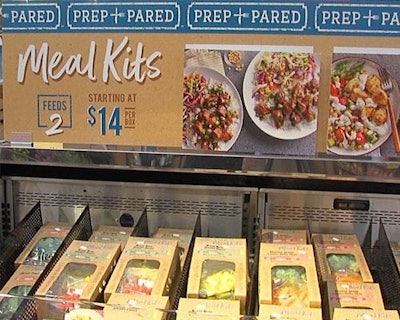
Since originally debuting in Sweden in 2007, meal kits have expanded into a profitable market, reaching doorsteps around the world.
After reaching America more than five years ago, meal kits quickly grew to a billion-dollar industry. Time has tempered growth and expectations for the kits, but the future continues to remain promising.
In a new report by Packaged Facts, Meal Kits: Trend and opportunities in the U.S., 3rd Edition, found the industry will continue to expand and grow through 2023, though at a more modest rate than previously expected.
The report estimates that the market had sales of $2.6 billion in 2017 and will grow by almost 22 percent by the end of 2018, reaching $3.1 billion. According to the report, growth is forecasted to decline from double-digit gains over the coming years to just single-digit gains.
However, the meal kit delivery service market will mature rapidly as other methods of meal kit sales become available. As a result, future growth in the market will require industry leaders to continue pivoting and adjusting their business models to retain current customers and reach new clientele. As more traditional stores offer meal kits as a product rather than as a service, the market will stabilize and become similar to other convenience grocery items that sell for a premium.
"The meal kit market is highly dynamic and prone to fluctuations, with the top meal kit providers falling in and out of favor since their introduction in the past years," says David Sprinkle, research director for Packaged Facts. "Further complicating things, market expansion is expected to be much more reliant on alternative purchase venues than the traditional subscription delivery model due in part to the convenience and flexibility of online shopping."
With online grocery becoming more popular than ever, meal kits are becoming a standard option in consumers' shopping carts. However, the problem for traditional subscription model is that the "on-demand" nature of online shopping through companies has led consumers expecting convenience and near-instant gratification.
Subscription delivery services often clash with the "on-demand" mentality of potential customers. Subscriptions attempt to entice more purchases and even when flexible, can lead customers into purchasing more than they want to buy at a given time to avoid increased fees. Those who have felt pressure are more likely to cancel their subscriptions. Additionally, many customers don't like the idea of being "locked in" by a subscription.
"It is unsurprising that many meal kit companies have been struggling to attract new customers and maintain existing ones under the subscription model. Paired with the retention problem is the struggle with attaining profitability due to the high costs of shipping fresh ingredients directly to consumers," says Sprinkle. "These challenges demand that meal kit companies tweak their business models and find alternative ways to reach customers as the potential market for meal kits as a product is much larger than the interest in meal kit delivery services as they currently exist."


















